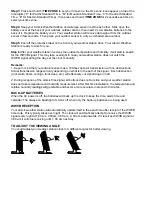
Step 3
Press and hold
+/ TIME ZONE
to set your time zone, the time zone icons appear on top of the
time digits (“P” for Pacific Standard Time, “M” for Mountain Standard Time, “C” for Central Standard
Time, “E” for Eastern Standard Time) , then press and hold
+/TIME ZONE
for 2 seconds each time to
select your time zone.
Step 4
Keep your Atomic Weather Station and wireless sensor next to each other. Slide open the
battery cover at the back of your wireless outdoor sensor, then insert 2 x AA alkaline batteries to the
back of it. Replace the battery cover. Your weather station will receive data signal from the outdoor
sensor in few seconds. Then place your outdoor sensor in a dry and shaded area outdoor.
Step 5
Peel off the protective label on the front of your weather station clock. Your Atomic Weather
Station is ready to work for you.
Step 6
After your weather station receives the outdoor temperature and humidity, it will start to search
for the WWVB signal. This may take overnight In case your weather station does not catch the
WWVB signal during the day, set the clock manually.
Remarks:
1. Keep in mind that your outdoor sensor has a 100-feet open air transmission with no obstructions.
Actual transmission range will vary depending on what is in the path of the signal. Each obstruction
(roof, walls, floors, ceilings, thick trees, etc.) will effectively cut signal range in half.
2. During reception of the atomic time signal, all buttons does not function and your weather station
does not take temperature and humidity measurement. After first time installation, the temperature and
relative humidity readings will get stable and become more accurate in around 30 minutes.
BACK-UP BATTERIES
When the AC power is off, the batteries will back up the clock to keep the time, alarm time and
calendar. The always-on backlight of LCD is off when only the back-up batteries are being used.
WWVB RECEPTION
Your atomic weather station will automatically update itself to the exact time after receipt of the WWVB
time code. This typically takes over night. The clock will automatically attempt to receive the WWVB
signal every night at 1:00 am, 2:00am, 3:00 am, 4: 00 am and onwards. If it receives WWVB signal at
3:00 am it will stop receiving until 1: 00 am next day.
TO ADJUST THE VIEWING ANGLE
You could adjust your weather station clock to 3 different angles for better viewing.







